Question of the Week: May 19, 2016
“Neil! What’s wrong with my St. Augustine? It’s just not greening up like usual.”
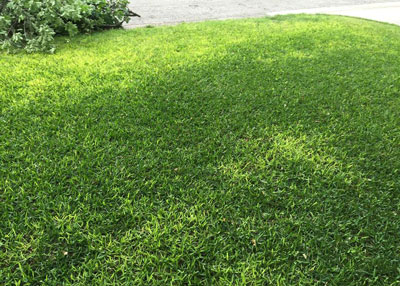
The answer to this one is somewhat challenging. Imagine yourself trying to describe this to me on a phone call, without benefit of a photo.
I grew up in Texas. I’ve grown St. Augustine since I was a kid. I’ve suffered its ups and its downs. Like many of our friends, it has its “baggage,” but we continue to love it.
But the problem for me is that identifying/diagnosing St. Augustine ills is really, really difficult if you’re not standing on top of the lawn in question. The problems overlap in their seasons, and the symptoms are very similar.
Actually, I ask my radio board operators/call screeners not to put St. Augustine questions up on the air unless we have absolutely no other calls. As you’ll see in what I’ve written below, it takes 10 minutes to go through the list, and I never do feel like I’ve identified their problem with certainty. It’s much better that they see photos and read descriptions rather than our trying to figure out the minute differences in symptoms. My board ops refer them to my website and Facebook page “Notes.”
Most Common St. Augustine Problems
Here is the sequence in which the problems will usually show up:
April/May: take all root rot (TARR, also known as take all patch). Grass is lethargic about greening up, may even be dead in patches. Application of 1 inch of sphagnum peat moss is best control. Fungus is repressed by the acidic interface. Conventional fungicides do not usually do much to help. Sun or shade.
Note: The sphagnum peat moss application is only effective in controlling TARR. I have so many people telling me that they have applied it in summer or fall and for things I know are not TARR – it’s not inexpensive. Double-check before you go to that expense.
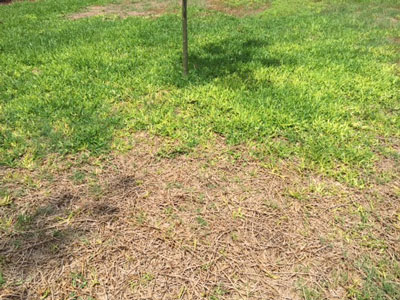
This is TARR as it appeared in April.
June-early September: chinch bugs. Grass appears to be dry, but watering does not help. Always in hottest, sunniest part of yard (usually return to the same spots each year). You can see the small, black insects at interface of dying and healthy grass. Look for irregular white diamonds on their wings. Treat entire yard with labeled insecticide.
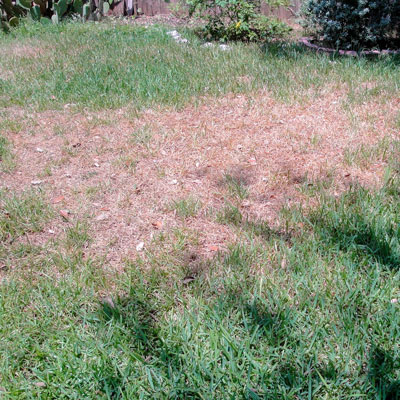
See the severe damage chinch bugs can do in only a few days. Browned area is actually dead. See dying grass in turf on bottom side of dead grass.
June-early September: gray leaf spot. Fungus causes yellowed streaking following applications of nitrogen. This is the precise reason I do not recommend feeding St. Augustine between June 15 and September 1. You will see diamond-shaped, gray-brown lesions on blades. Fungicides offer some help, but not applying nitrogen gives best results. Sun or shade.
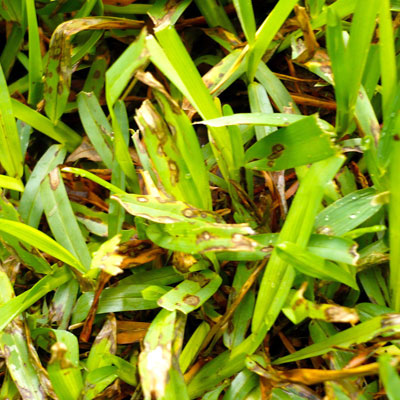
Gray-brown lesions, often along midribs, are evidence of this summer disease.
Late September through first frost: brown patch. Fungal infection of grass blades attacking where blades attach to runners. Grass turns yellow, then quickly brown in round patches 18-30 inches across. Blades pull loose easily from runners. Turf fungicides control it easily and grass rebounds if there is sufficient time before frost. Weakens grass enough that winter damage can occur.
Note: In milder winters and in South Texas, where St. Augustine does not freeze and go brown, the fungus may overwinter and appear the following spring. This has happened across Texas this spring as far north as the I-20/30 corridor.
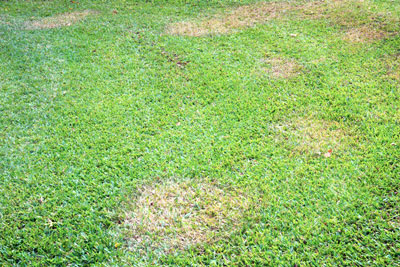
With brown patch, round browning areas are visible in mid-fall until frost. Left untreated, its damage may reappear the following spring in April.
And the most important warning of all:
St. Augustine is shade-tolerant. It is not shade-proof. Even St. Augustine requires 5 or 6 hours of direct sunlight daily to hold its own, 6 to 8 if you want it to grow vigorously.
If you have areas where St. Augustine just won’t grow, check the amount of shade that area has.
My all-time most-asked question of my entire career is, “Neil, why isn’t my St. Augustine growing beneath my trees?” When I suggest it might be the shade, they comment, disagree and even argue, at which point I just quietly thank them for calling. There is only so much I can do.
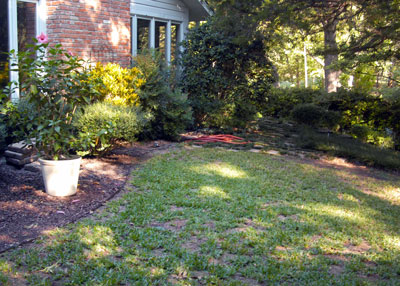
When shade becomes excessive, St. Augustine starts to decline, as it did in the Sperry landscape several years ago. This area is all shade-tolerant groundcover now.
